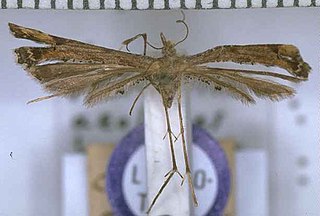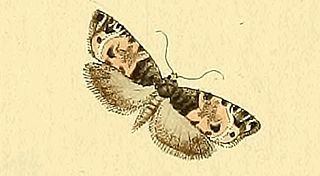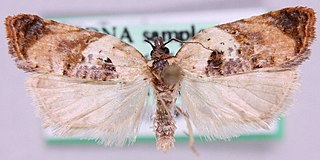Related Research Articles

The Archipini are a tribe of tortrix moths. Since many genera of these are not yet assigned to tribes, the genus list presented here is provisional.

Enarmonia formosana, the cherrybark tortrix or cherry-bark moth, is a small but colorful moth species of the family Tortricidae. It is native to all of northern and western Europe, ranging south to the Maghreb. North of the Alps its range extends eastwards to Siberia and Kazakhstan. Possibly and most likely introduced populations are found in Asia Minor and North America, respectively.

Notocelia uddmanniana, the bramble shoot moth, is a moth of the family Tortricidae. It is found in Western Europe and the area surrounding the Mediterranean Sea all the way up to the Caucasus, Kazakhstan, Iran and China.
Licigena is a monotypic genus of moths belonging to the subfamily Olethreutinae of the family Tortricidae. Its sole species is Licigena sertula, which has been found in Sri Lanka. Both the genus and species were first described by Alexey Diakonoff in 1982.
Saetotaenia is a genus of moths belonging to the family Tortricidae. It contains only one species, Saetotaenia velitans, which is found in Brazil.

Epitymbia alaudana is a species of moth of the family Tortricidae. It is found in Australia.

Amblyptilia aeolodes is a moth of the family Pterophoridae. This species was first described by Edward Meyrick in 1902. It is endemic to New Zealand and is found on the Chatham Islands, Big South Cape Island, and the subantarctic Auckland and Campbell Islands.The larvae feed on dicotyledonous herbs.

Cochylichroa atricapitana, the black-headed conch, is a moth of the family Tortricidae. It is found in China (Xinjiang) and the eastern Palearctic and most of Europe.
"Capua" euryochra is a species of moth of the family Tortricidae. It is found in Australia, where it has been recorded from Queensland and New South Wales.
"Capua" tetraplasia is a species of moth of the family Tortricidae. It is found in Australia, where it has been recorded from Queensland.
Lobesia extrusana is a species of moth of the family Tortricidae. It is found in Australia, where it has been recorded from Queensland and New South Wales.

Coeloptera vulpina is a species of moth of the family Tortricidae. It is found in Australia, where it has been recorded from New South Wales and Queensland.
"Tortrix" celatrix is a species of moth of the family Tortricidae. It is found in Australia, where it has been recorded from Queensland.

Ecclitica torogramma, also known as the ponga ugly nestmaker, is a species of moth of the family Tortricidae. It is endemic to New Zealand.

Epichorista siriana is a species of moth of the family Tortricidae. It is found in New Zealand.

Epichorista aspistana is a species of moth of the family Tortricidae. It is endemic to New Zealand and has been collected in Canterbury and Otago. This species inhabits moist grassy areas at altitudes ranging from sea level to 1650m. Larvae feed on species within the genus Acaena. Adults are on the wing in November to February.

Notocelia incarnatana, the chalk rose bell, is a species of moth of the family Tortricidae. It is found in China, Mongolia, Japan, Russia, Kazakhstan and Europe, where it has been recorded from most of the continent, except parts of the Balkan Peninsula.

Pyrgotis plinthoglypta is a species of moth of the family Tortricidae. It is endemic to New Zealand and is found throughout the whole country. The preferred habitat of this species is native forest. The larvae of this species feeds on rimu leaves from under a silken web. It pupates in loose cocoons amongst rimu foliage. Adults are on the wing from October to May and are night flying. They are attracted to light and can be collected by beating their host tree. The adult insect resembles a small dried fragment of rimu foliage when at rest.

Acleris permutana is a species of moth of the family Tortricidae. It is found in Ireland, Great Britain, Portugal, Spain, France, Belgium, the Netherlands, Germany, Denmark, Sweden, Austria, Italy, the Czech Republic, Slovakia, Slovenia, Croatia, Hungary, Romania, North Macedonia and Russia. The habitat consists of coastal sandhills and limestone.

Cnephasia paterna is a species of moth in the family Tortricidae. It is endemic to New Zealand. This species is classified as Nationally Endangered by the Department of Conservation.